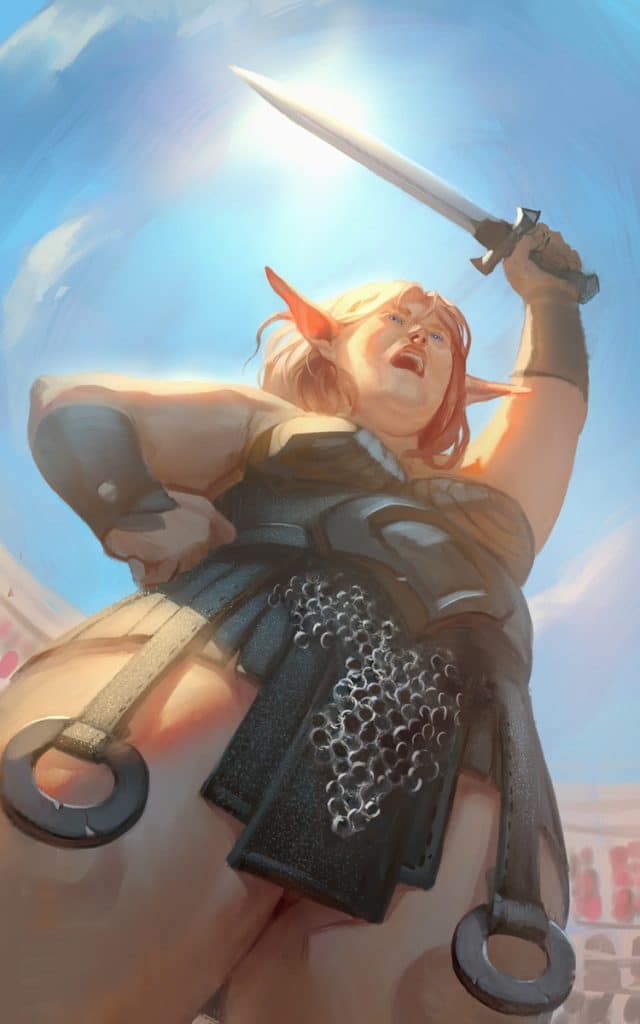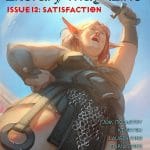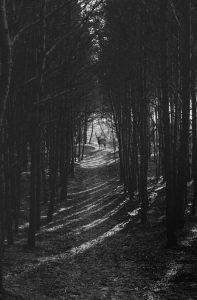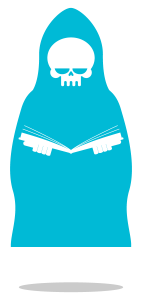Agency is integral to obtaining satisfaction. For some, satisfaction can only be achieved through the joy, relief, and adrenaline of taking control and discovering that seldom-found quiet place in your mind. For issue 12, we wanted bright colours. A sunny sky, clear of clouds, and the rich yellow hues inspired by Seville’s Plaza de toros de la Real Maestranza de Caballería. Instead of a bullring, we imagined a gladiator pit–a warrior calling on their opponents, striking fear with their authority and confidence.
We sought out Karina Serdyuk, a Russian artist whose work often features women, looking with confidence into the audience. Flipping through her Artstation profile, it’s clear that Karina excels in drawing musculature, her characters are often posed or in mid-movement. Instead of a lithe, honed figure, we asked Karina to take on drawing a different body type than what she displays in her portfolio.
Our fighter had to be strong. Someone that could take you and your family in a fight. For inspiration we researched female weightlifters and came across photos of Sarah Robles, a competitive weightlifter who was the first US athlete to win a medal in Olympic weightlifting in 16 years. In the photos we found, Sarah’s joy was unrestrained. She was proud, happy and strong. Better yet, she knew it.
 During our initial conversation, Karina asked for a concrete idea of the illustration. We always love seeing what writer’s bring to the table, so we spelled out our gladiator idea but only said that we wanted a fantasy cover.
During our initial conversation, Karina asked for a concrete idea of the illustration. We always love seeing what writer’s bring to the table, so we spelled out our gladiator idea but only said that we wanted a fantasy cover.
During the first sketches of the design, there was only the body form. We saw hints of an outfit and the pose, but none of the details. The final image held the full details of our warrior’s vambraces, armour, and extended elf ears. This might be the first time we’ve seen a fat elf, and we loved it.
Seeing the initial illustrations of the sketch also put to bed one of our lingering fears. This was our first time purposefully commissioning a cover with a fat character, and we worried that the end result would be more curvy than expressly fat. Throughout the process, Karina embraced drawing the body style and created a fierce warrior. We asked Karina if the drawing process differed from the more svelte characters that are often commissioned:
I’d say painting the body was easier since the shapes are softer and the muscles aren’t as visible. The face was a challenge though, mostly because of the angle.
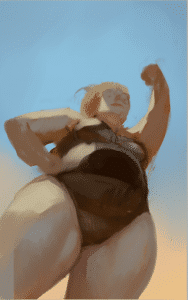 Working with Karina was a fantastic process, she was quick to respond and even finished the piece months ahead of the deadline. It was easily an eight-month wait from her completing the artwork and its launch on Apparition Lit’s website. The whole world changed in between. Even during some of the darker periods of the last few months, there remained a thrill in looking in our folders and seeing our warrior facing down their nemesis. Let’s face our demons head-on, with a sparkle in our eyes and a weapon in hand.
Working with Karina was a fantastic process, she was quick to respond and even finished the piece months ahead of the deadline. It was easily an eight-month wait from her completing the artwork and its launch on Apparition Lit’s website. The whole world changed in between. Even during some of the darker periods of the last few months, there remained a thrill in looking in our folders and seeing our warrior facing down their nemesis. Let’s face our demons head-on, with a sparkle in our eyes and a weapon in hand.
Q&A
Standard interview question: where are you from, how did you start drawing?
I am from Russia. I don’t remember how and why I started drawing and I am not even sure what I can call a starting point. I vaguely recall that my social circle mostly consisted of artists back then, so it might have influenced me. Also I wanted to have my characters and ideas on paper.
Are there any personal elements (like family history or personal stories) that you try to incorporate into your artwork?
I am a relatively closed-off person and I don’t like to depict things from my life directly. They do affect my work, obviously, but mostly on the subconscious level.
What are some of your biggest artistic influences (both visual and non-visual artists, like writers and musicians)?
I’d say most of the influences I have are visual. Other artists, video games, movies, etc.
You posted that you’re practicing for the Hànyǔ Shuǐpíng Kǎoshì –a Chinese proficiency test– has learning another language impacted how you develop your art in any way?
I am not practicing for the test per se, I just want to learn the language. I am still on a very early stage though.
And the influence probably comes not from the languages themselves, but from the content I learn them for.
I like learning languages, spent some time learning Japanese and German, but English is the only one I am somewhat fluent in (I’ve never taken a formal test though). But even in English I have a very strong Russian accent.
You work a lot of commissions, have you discovered any new fandoms from learning about it through people’s original characters?
I don’t remember, probably not.
How has your art style and commission processed changed over the years?
I don’t think my work changed much style-wise, mostly I am just able to draw things closer to how I imagine them than, say, five years ago.
I originally found examples of your artwork through the #portfolioday hashtag on Twitter. Self promotion seems to be the main way of curating an audience and showcasing your style. How do you promote yourself and others online?
I participate in artshares and in the trending art tags, but I don’t have a definite strategy to promote myself – mostly I just talk to people. I comment and retweet the artists whose work I like and people who like my work comment and retweet me.
I am not particularly popular and I don’t know if I am qualified to give an advice, but it’s called “social media” for a reason and it’s much easier to get by if you are, well, social. Seriously though, in most cases just talking to people can get you pretty far.
You posted recently that you have difficulty tricking your brain into enjoying things — for example, reading kids books to learn a new language rather than the textbook– has that ever impacted how you approach your artwork?
I either enjoy things or don’t enjoy things. I can get through the chores I don’t particularly like just fine if they benefit me, but when someone tells me “hey, you can’t just do it, you are supposed to enjoy it” it just annoys me.
One thing I really love about the artwork you made for us is how sunny and bright it is! Normally we end up asking for more shadowed pieces but the clear blue sky completely won us over. How did working with a brighter background affect your drawing?
Thank you, I am happy you liked it!
I usually prefer darker color schemes myself, but there I felt like the sunny background would work better.
You generally use a lot of highly saturated colours in your artwork, how do you use colour to influence character design?
Colors used to be one of my weak points as an artist – I was really bad with them. So once I more or less understood how to make them work I just couldn’t get enough of them.
I just really like bright colors and try to shove them everywhere I can.
This was our first time purposefully commissioning a cover with a fat character. I personally was a little worried we’d end up with a character that was more curvy than expressly fat. I love that you embraced drawing the body style and created a character that seemed so fierce. How did drawing her differ from the more svelte characters that are commissioned?
I’d say painting the body was easier since the shapes are softer and the muscles aren’t as visible. The face was a challenge though, mostly because of the angle.
One question that I’ve wanted to ask since we started working together, you asked early on how violent and bloody could the portrait be. I need to know, how gory were you envisioning?
One of the things I had in mind was the character pointing a sword in the camera, but in the end decided that the sword in the sky looks better.
I have a relatively high tolerance for gore in art and fiction (i.e. if it isn’t done to real people), so I always prefer to ask – better safe than sorry.
You’ve mentioned that ellipses –a shape that creates perspective for circular objects– aren’t your favourite element to work on. How do you tackle more difficult elements of artwork?
No, that’s not the case with the ellipses. It’s not that they are particularly difficult to draw for me personally, it’s just that they are one of the things I notice immediately, so if someone draws them weirdly, my eyes get glued to them.
When it comes to the difficult things in general – I either google references and get through it or ask my artist friends for feedback.
You’re not afraid to call out misogyny, TERFdom, hate speech, or predatory art/stores on Twitter. As an artist whose body of work is mainly online, has your activism affected your online presence?
But… I don’t remember calling anyone out? I retweet some posts asking for help and those I think need more visibility, but rarely have anything useful to add to the conversation myself and I am nowhere near an activist.
Alright, I need to ask. You finished the artwork early in the year. How has COVID/isolation/general pandemic terribleness impacted you and your art?
I am a couch potato, so not much, to be honest.
What would be your dream project to work on?
I don’t currently have the means to do it, so let’s leave it a secret.
Last question! Do you have anything to promote to our readers?
I don’t really have anything to promote, but take care of yourself and wear a mask.
